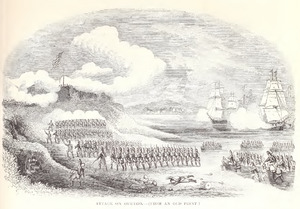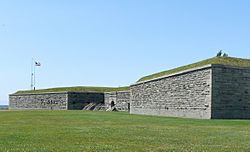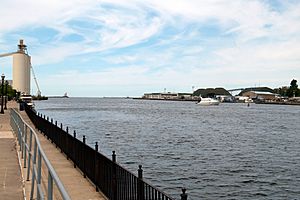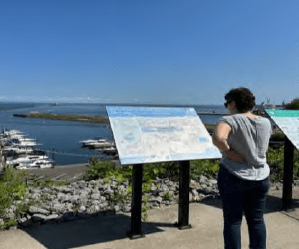Oswego, New York facts for kids
Quick facts for kids
Oswego
|
|
|---|---|
| City of Oswego | |
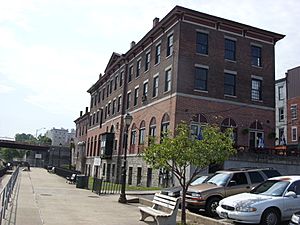
Market House, Oswego, NY
|
|
| Nickname(s):
The Port City
|
|
| Motto(s):
"Where the Water Never Ends"
"Cool by Nature" |
|

Location in Oswego County and the state of New York.
|
|
| Country | |
| State | New York |
| County | Oswego |
| As a Fort | 1796 |
| Incorporated (village) | 1828 |
| Incorporated (city) | 1848 |
| Government | |
| • Type | Mayor-Council |
| Area | |
| • Total | 11.23 sq mi (29.08 km2) |
| • Land | 7.61 sq mi (19.72 km2) |
| • Water | 3.61 sq mi (9.36 km2) 31% |
| Elevation | 285 ft (87 m) |
| Population
(2020)
|
|
| • Total | 16,921 |
| • Density | 2,222.35/sq mi (858.06/km2) |
| Demonym(s) | Oswegonian |
| Time zone | UTC−5 (EST) |
| • Summer (DST) | UTC−4 (EDT) |
| ZIP Code |
13126
|
| Area code(s) | 315 |
| FIPS code | 36-55574 |
| GNIS feature ID | 0959525 |
| Website | www.oswegony.org |
Oswego (/ɒsˈwiːɡoʊ/) is a city in Oswego County, New York, United States. About 17,000 people live here, based on the 2020 census. Oswego is located where the Oswego River meets Lake Ontario. This area is in Upstate New York, about 40 miles (64 km) northwest of Syracuse.
The city calls itself "The Port City of Central New York." It is also the main city of Oswego County. The first European settlement in Oswego was a British trading post built in 1722. It became a village in 1828 and a city in 1848.
During the War of 1812, British forces briefly took over the city. However, they were defeated nearby later that month. The building of the Oswego Canal helped the city grow a lot. It brought more people and businesses. Oswego was also a major rail hub for many years.
Today, Oswego's economy mainly relies on making things and providing services. The city is led by a mayor, currently Rob Corradino, and a city council. Oswego Speedway is a famous car racing track. SUNY Oswego is a big university near the city.
Contents
History of Oswego
Early Beginnings
The British set up a trading post in this area in 1722. They later built a wooden fence around it, which became Fort Oswego. The name "Oswego" comes from an Iroquois word meaning "pouring out place." The first fort at the site of today's Fort Ontario was built by the British in 1755. They called it the "Fort of the Six Nations."
Fort Ontario: A Military Story
The French destroyed Fort Ontario during the Battle of Fort Oswego in the French and Indian War. The British started building a second fort there in 1759. During the American Revolution, American troops destroyed it again in 1778. The British took it back in 1782 and finally gave it to the U.S. in 1796.
In the War of 1812, British forces attacked Fort Ontario. They wanted to stop supplies from reaching American troops. The Americans were later defeated near Oswego that same month. The U.S. military kept a presence at Fort Ontario throughout the 1800s.
Oswego's Growth and Development
Oswego became a village on March 14, 1828. The Oswego Canal, which connects to the Erie Canal, opened in 1829. This helped the city grow a lot. Oswego officially became a city in 1848.
In the 1850s, Oswego was home to the Oswego Water Cure center. People came here for special water treatments, which helped the city grow even more.
Railroads and the Port
Oswego is home to the Port of Oswego. It was once a major center for several railroads. These included the New York Central Railroad, the Delaware, Lackawanna and Western Railroad, and the New York, Ontario and Western Railway. These railways helped fuel steamships at the Port of Oswego.
Passenger train service continued until the mid-1940s and early 1950s. Today, some old train stations still stand. A tunnel from the old O&W railway is now used as a walking and biking path.
Fort Ontario's Modern History
Fort Ontario was rebuilt between 1839 and 1844. Major improvements were planned but not finished. By 1901, the old fort was no longer used by the military.
During World War II, Fort Ontario became a special camp. It housed Jewish refugees from Europe. This was the only place in the United States that sheltered Jewish refugees during the war.
In 1946, the fort was given to New York State. It was used to house veterans and their families after the war. Today, Fort Ontario is a historic site. People can visit and learn about its past. Costumed guides show what life was like at the fort in the 1860s.
World War II Refugee Camp: Safe Haven
In 1944, during World War II, President Franklin D. Roosevelt created a camp at Fort Ontario. This camp was for people who survived the the Holocaust.
The fort was called the Fort Ontario Emergency Refugee Shelter, or "Safe Haven." About 982 Jewish refugees lived there from August 1944 to February 1946. They came from 18 different European countries.
The refugees were kept behind barbed wire. They had to sign papers agreeing to return to their home countries after the war. But because of public pressure, President Harry S. Truman allowed them to apply for U.S. citizenship.
The camp had 200 buildings, which were old army barracks. Today, this site is the Safe Haven Museum.
Geography and Climate
Oswego covers about 11.2 square miles (29.1 km²). Most of this is land, but about 3.6 square miles (9.2 km²) is water.
The city is on the southeastern shore of Lake Ontario. It's right where the Oswego River flows into the lake. Oswego is about 35 miles north of Syracuse. The elevation is 298 feet (91 meters) above sea level.
Oswego is known for its very snowy winters. It's in the "Snowbelt" region, which gets a lot of lake effect snow. Some winters, Oswego gets over 300 inches (762 cm) of snow! In 2007, about 130 inches (330 cm) of snow fell in just two weeks. This was a new record for the city.
Nearby Communities
- Oswego: This is the larger town that surrounds the city.
- Minetto: A town located south of Oswego.
- Scriba: A town located east of Oswego.
- Southwest Oswego: A small community west of the city.
- Fruit Valley: Another small community west of the city.
Weather in Oswego
Oswego has four distinct seasons: cold, snowy winters and warm, often humid summers. The city is famous for its heavy snowfall, averaging about 140 inches (356 cm) each winter. This is mostly due to lake-effect snow from Lake Ontario.
Lake Ontario also helps keep temperatures milder. Winters are a bit warmer and summers are cooler than places further inland. Days above 90°F (32°C) are rare, and Oswego has never reached 100°F (38°C). The lake also helps extend the growing season in the fall.
| Climate data for Oswego, New York (1991–2020 normals, extremes 1926–present) | |||||||||||||
|---|---|---|---|---|---|---|---|---|---|---|---|---|---|
| Month | Jan | Feb | Mar | Apr | May | Jun | Jul | Aug | Sep | Oct | Nov | Dec | Year |
| Record high °F (°C) | 69 (21) |
69 (21) |
83 (28) |
90 (32) |
91 (33) |
96 (36) |
95 (35) |
97 (36) |
96 (36) |
86 (30) |
79 (26) |
69 (21) |
97 (36) |
| Mean maximum °F (°C) | 53.2 (11.8) |
51.6 (10.9) |
63.0 (17.2) |
77.8 (25.4) |
83.8 (28.8) |
88.4 (31.3) |
89.8 (32.1) |
89.6 (32.0) |
86.0 (30.0) |
77.4 (25.2) |
66.4 (19.1) |
54.9 (12.7) |
91.4 (33.0) |
| Mean daily maximum °F (°C) | 31.1 (−0.5) |
33.2 (0.7) |
40.9 (4.9) |
53.2 (11.8) |
65.7 (18.7) |
74.8 (23.8) |
79.6 (26.4) |
78.5 (25.8) |
71.6 (22.0) |
59.2 (15.1) |
47.3 (8.5) |
36.7 (2.6) |
56.0 (13.3) |
| Daily mean °F (°C) | 25.0 (−3.9) |
26.7 (−2.9) |
34.2 (1.2) |
45.3 (7.4) |
56.8 (13.8) |
66.1 (18.9) |
71.5 (21.9) |
70.4 (21.3) |
63.4 (17.4) |
52.1 (11.2) |
41.4 (5.2) |
31.3 (−0.4) |
48.7 (9.3) |
| Mean daily minimum °F (°C) | 18.9 (−7.3) |
20.2 (−6.6) |
27.4 (−2.6) |
37.3 (2.9) |
47.9 (8.8) |
57.4 (14.1) |
63.4 (17.4) |
62.3 (16.8) |
55.2 (12.9) |
45.1 (7.3) |
35.4 (1.9) |
26.0 (−3.3) |
41.4 (5.2) |
| Mean minimum °F (°C) | −0.9 (−18.3) |
3.1 (−16.1) |
9.3 (−12.6) |
25.2 (−3.8) |
35.6 (2.0) |
44.7 (7.1) |
53.1 (11.7) |
51.3 (10.7) |
40.5 (4.7) |
31.5 (−0.3) |
20.9 (−6.2) |
7.8 (−13.4) |
−4.0 (−20.0) |
| Record low °F (°C) | −21 (−29) |
−21 (−29) |
−9 (−23) |
13 (−11) |
28 (−2) |
36 (2) |
44 (7) |
42 (6) |
30 (−1) |
21 (−6) |
4 (−16) |
−23 (−31) |
−23 (−31) |
| Average precipitation inches (mm) | 3.76 (96) |
2.85 (72) |
3.03 (77) |
3.48 (88) |
3.29 (84) |
3.38 (86) |
3.37 (86) |
3.45 (88) |
3.92 (100) |
4.59 (117) |
4.12 (105) |
3.89 (99) |
43.13 (1,096) |
| Average snowfall inches (cm) | 44.7 (114) |
35.3 (90) |
17.1 (43) |
2.8 (7.1) |
0.0 (0.0) |
0.0 (0.0) |
0.0 (0.0) |
0.0 (0.0) |
0.0 (0.0) |
0.2 (0.51) |
9.4 (24) |
30.6 (78) |
140.1 (356) |
| Average extreme snow depth inches (cm) | 20.0 (51) |
20.8 (53) |
12.8 (33) |
1.3 (3.3) |
0.0 (0.0) |
0.0 (0.0) |
0.0 (0.0) |
0.0 (0.0) |
0.0 (0.0) |
0.1 (0.25) |
4.0 (10) |
11.0 (28) |
26.3 (67) |
| Average precipitation days (≥ 0.01 in) | 20.1 | 16.4 | 14.6 | 13.8 | 12.6 | 11.8 | 11.0 | 10.9 | 11.0 | 15.1 | 16.3 | 18.8 | 172.4 |
| Average snowy days (≥ 0.1 in) | 18.2 | 14.5 | 8.5 | 2.2 | 0.0 | 0.0 | 0.0 | 0.0 | 0.0 | 0.3 | 5.6 | 13.0 | 62.3 |
| Source: NOAA | |||||||||||||
Getting Around Oswego
You can reach Oswego by car using New York State Route 481 from Interstate 81. This route connects Oswego to Syracuse and Fulton. New York State Route 104 runs east and west, connecting Oswego to Rochester.
Public buses are available through the Central New York Regional Transportation Authority. They offer service within Oswego and connections to Fulton and Syracuse. Oswego County Public Transit also connects Oswego to smaller towns in the county.
People of Oswego
| Historical population | |||
|---|---|---|---|
| Census | Pop. | %± | |
| 1850 | 12,205 | — | |
| 1860 | 16,816 | 37.8% | |
| 1870 | 20,910 | 24.3% | |
| 1880 | 21,116 | 1.0% | |
| 1890 | 21,842 | 3.4% | |
| 1900 | 22,199 | 1.6% | |
| 1910 | 23,368 | 5.3% | |
| 1920 | 23,626 | 1.1% | |
| 1930 | 22,652 | −4.1% | |
| 1940 | 22,062 | −2.6% | |
| 1950 | 22,647 | 2.7% | |
| 1960 | 22,155 | −2.2% | |
| 1970 | 20,913 | −5.6% | |
| 1980 | 19,793 | −5.4% | |
| 1990 | 19,195 | −3.0% | |
| 2000 | 17,954 | −6.5% | |
| 2010 | 18,142 | 1.0% | |
| 2020 | 16,921 | −6.7% | |
| U.S. Decennial Census | |||
In 2010, there were 18,142 people living in Oswego. Most residents (94.1%) were White. About 2.3% were African American, and 1.5% were Asian. People of Hispanic or Latino background made up 5.1% of the population.
Famous People from Oswego
Many interesting people have connections to Oswego:
- Joey Belladonna: Singer for the heavy metal band Anthrax.
- Owen Benjamin: An actor and comedian.
- David Branshaw: A professional golfer on the PGA Tour.
- Al Roker: A national weather anchor on NBC's TODAY show.
- Erik Cole: An NHL hockey player and Olympian.
- Noel Francisco: Former Solicitor General of the United States.
- George Grant: A doctor and inventor.
- Robert M. Hensel: A disability advocate, poet, and world record holder.
- David H. McConnell: The person who started California Perfume Company, which later became Avon Cosmetics.
- Dan Reynolds: A nationally published cartoonist and author.
- Mary E. Walker: The only female doctor during the American Civil War. She was also the only woman to receive the Medal of Honor.
Fun Things to Do in Oswego
Oswego has a long and interesting history. You can learn about it by visiting museums like the H. Lee White Marine Museum and Fort Ontario. There are also many historical monuments in the city's parks.
Several places in Oswego are listed on the National Register of Historic Places. These include the Market House and the Oswego City Hall. In 2024, the Lake Ontario National Marine Sanctuary was created. It protects historic shipwrecks and important Native American sites in Lake Ontario.
Rosemary Nesbitt was a famous historian from Oswego. She founded the Marine Museum and wrote books about the city's history. Every Halloween, she would tell spooky stories about the city.
Ludwig Bemelmans, who wrote the popular 'Madeline' stories, was stationed at Fort Ontario in 1917. He wrote a book about his experiences called "My War with the United States."
You can enjoy boating, fishing, and hiking in Oswego. The city also has three ice-skating rinks, a large public pool, bowling, and the historic Oswego Theater.
Every year, Oswego hosts the Oswego Harborfest. This is a four-day festival with music, culture, and food. It takes place around the Oswego Harbor and ends with a fireworks show. The festival is free and draws many visitors each year.
In 2007, the SUNY Oswego Lakers men's hockey team won the NCAA Division III Ice Hockey Championship. This was the school's first national championship in a team sport. The team plays in the modern Marano Campus Center, built on Lake Ontario.
Media and News
Oswego has its own newspaper, The Palladium Times. There's also Oswego County Today and the student newspaper The Oswegonian. You can listen to local radio stations like WRVO, WSGO, WNYO, and WMVN.
The city also has two local TV stations. WTOP is run by students at SUNY Oswego. WBUC is the TV station for Oswego High School.
Education in Oswego
The city is part of the Oswego City School District. This district includes:
- One high school (grades 9–12)
- One middle school (grades 7 and 8)
- Five elementary schools (grades K–6)
There are also private schools like Trinity Catholic School (PreK–6) and Oswego Community Christian School (PreK–8).
The State University of New York at Oswego (SUNY Oswego) is a major university. Parts of its campus are in Oswego City, and other parts are just west in the Town of Oswego.
Images for kids
See also
 In Spanish: Oswego (Nueva York) para niños
In Spanish: Oswego (Nueva York) para niños



